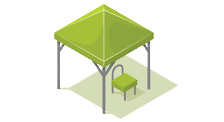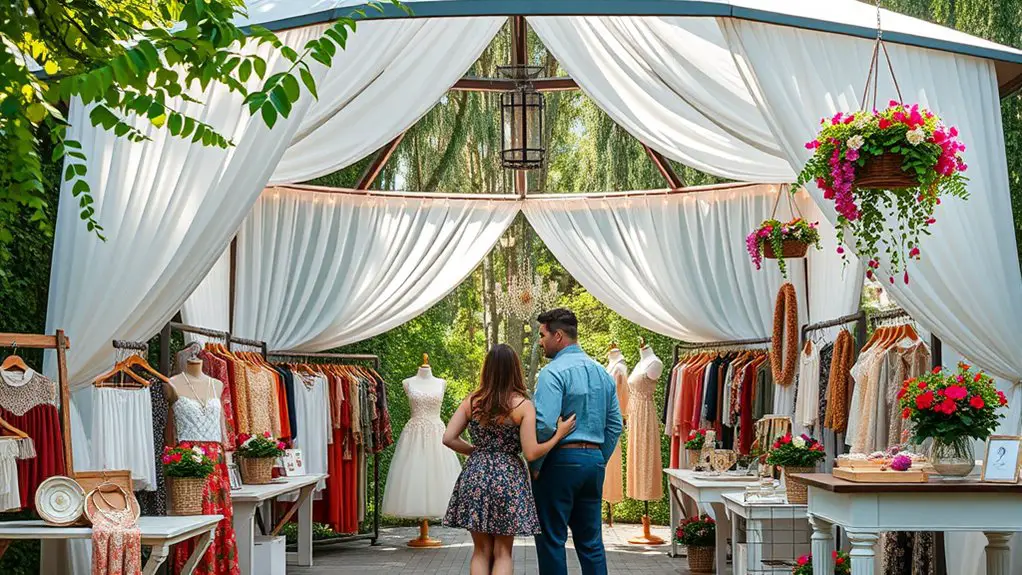To plan a local designer showcase in your gazebo, start by choosing the right date and time, considering weather and local events. Select innovative designers and define the layout to create an inviting atmosphere. Organize logistics like tables, chairs, and lighting, and promote your event through social media and local businesses. Engage attendees with interactive elements, and foster discussions between designers and guests. With careful planning, you can create a memorable experience that shines a spotlight on local talent. Discover more tips to enhance your showcase!
Choosing the Right Designers for Your Showcase
Choosing the right designers for your showcase can make all the difference in creating an impactful event. Start by defining your designer criteria, which should align with your event’s vision and theme. Look for innovative thinkers who embrace creativity and possess unique styles that resonate with your audience’s desire for freedom.
During the selection process, consider their past work and how it reflects their ability to captivate. Don’t hesitate to reach out for references or testimonials; this can provide insights into their professionalism and reliability.
Engage in conversations with potential designers to gauge their passion and enthusiasm. Ultimately, you want to collaborate with those who share your excitement for this showcase and contribute to its success.
Setting the Date and Time
When planning a designer showcase, it’s essential to set a date and time that maximizes attendance and engagement. To guarantee a successful event, consider these key factors:
Setting the right date and time for your designer showcase is crucial for maximizing attendance and ensuring engagement.
- Weather Considerations: Check forecasts to avoid rainy or overly hot days, which could deter attendees.
- Community Calendars: Look for local events or holidays that might conflict with your date, as this could impact turnout.
- Time of Day: Aim for late afternoon or early evening when more people are likely free.
- Advance Notice: Give attendees ample time to plan by announcing the date at least a few weeks ahead.
Designing the Layout of Your Gazebo
As you begin designing the layout of your gazebo, it’s important to envision how the space will serve your showcase’s purpose and enhance the overall experience. A well-thought-out gazebo layout can create an inviting atmosphere, allowing guests to mingle and appreciate the designs on display.
Consider these seating arrangements:
| Seating Type | Description |
|---|---|
| Lounge Chairs | Comfortable for relaxation |
| Benches | Great for larger groups |
| Folding Chairs | Easy to move and store |
| High Tables | Encourages casual conversation |
| Floor Cushions | Adds a cozy, informal vibe |
Incorporating comfortable seating can significantly enhance the cozy atmosphere of your gazebo during the showcase.
Organizing Logistics and Supplies
After establishing an inviting layout for your gazebo, the next step involves organizing the logistics and supplies necessary for a successful designer showcase. You’ll want to create a logistics checklist to guarantee you don’t overlook anything essential. Here’s a quick list to guide your supply sourcing:
- Tables and Chairs: Arrange enough seating for designers and guests.
- Display Materials: Gather items like easels or stands for showcasing designs.
- Lighting: Confirm adequate lighting to highlight the designs, especially as evening approaches.
- Promotional Materials: Prepare flyers or brochures to share information about the designers.
- Additionally, consider setting up a mosquito netting to ensure a comfortable environment for both designers and guests, protecting them from pests during the showcase.
Promoting Your Event
To make your designer showcase a success, you’ll want to harness the power of social media marketing and engage local partnerships. Utilize platforms like Instagram and Facebook to showcase your designers and create buzz around the event. Additionally, collaborating with local businesses can expand your reach and draw in a crowd that’s excited to see what you’ve curated.
Social Media Marketing
While you might have a stunning designer showcase planned, its success largely hinges on effective social media marketing. To engage your audience and boost attendance, focus on these strategies:
- Choose the Right Platforms: Select social media platforms where your target audience hangs out, like Instagram or Facebook.
- Create Eye-Catching Content: Use high-quality images and videos that highlight your designers’ work, sparking interest and excitement.
- Utilize Audience Targeting: Leverage targeted ads to reach potential attendees based on their interests and demographics.
- Engage and Interact: Respond to comments and messages promptly to build a community around your event and keep the conversation going.
Local Partnerships Engagement
Engaging local partnerships can greatly amplify the reach and impact of your designer showcase. Collaborate with local businesses, schools, and community organizations to enhance your community outreach. By forming these alliances, you tap into their networks, spreading the word about your event far and wide.
Consider offering partnership benefits like shared marketing efforts, exclusive discounts for their customers, or co-hosted workshops. This not only builds excitement but also fosters a sense of community ownership.
Think about inviting local influencers or artists to participate; their involvement can draw in diverse crowds. Remember, when you unite forces, you create a vibrant atmosphere that showcases local talent while celebrating your community’s spirit. Together, you can generate buzz and elevate your event’s success.
Creating an Engaging Experience for Attendees
How can you guarantee that attendees leave your designer showcase feeling inspired and connected? By creating an engaging experience that resonates with them. Here are a few ideas to elevate your event:
- Interactive Installations: Set up installations where attendees can touch, explore, and immerse themselves in the designs.
- Live Demonstrations: Invite designers to showcase their skills live, allowing attendees to witness the creative process firsthand.
- Feedback Stations: Set up areas for attendee feedback to foster connection and show you value their opinions.
- Networking Zones: Create spaces dedicated to mingling, encouraging conversations among attendees, designers, and local artists.
With these elements, you’ll cultivate a vibrant atmosphere that leaves a lasting impression and nurtures a sense of community.
Collaborating With Local Businesses and Sponsors
Partnering with local businesses and sponsors can greatly enhance the impact of your designer showcase, as these collaborations often bring added resources and community connections. Start by identifying potential sponsors who align with your vision; think creatively about sponsorship opportunities that benefit both parties. For instance, local cafes could provide refreshments, while boutiques might offer gift bags.
Engage in business networking to build relationships and discuss how they can contribute. You could host joint promotional events to generate buzz before the showcase. By involving local businesses, you not only elevate your event but also foster a sense of community. Remember, these partnerships can lead to lasting connections, enhancing your showcase’s success and creating a vibrant atmosphere that celebrates local talent.
Evaluating the Success of Your Showcase
What criteria will you use to evaluate the success of your designer showcase? Understanding this can help you refine future events. Here are four key factors to take into account:
- Attendance Numbers: Did you meet your target audience size?
- Sales and Orders: How much product was sold or ordered during the event?
- Feedback Collection: Gather insights through attendee surveys; what did they love, and what could improve?
- Engagement Levels: Were attendees actively participating, asking questions, and interacting with designers?
Frequently Asked Questions
What Is the Ideal Number of Designers to Feature?
When considering designer selection, aim for 5 to 8 designers. This balance guarantees audience engagement without overwhelming guests, allowing each designer to shine while keeping the atmosphere lively and interactive. You’ll create a memorable experience!
How Can I Manage Crowd Control During the Event?
Did you know that 75% of event-goers appreciate organized spaces? To manage crowd control, implement crowd engagement strategies like interactive displays and establish safety measures, ensuring everyone enjoys the showcase while staying safe and relaxed.
What Permits Do I Need for Hosting an Event in a Gazebo?
You’ll need to check local regulations for event permits. Often, permits for gatherings, noise, and food may apply. It’s best to consult your municipality’s guidelines to guarantee a smooth, compliant experience for everyone involved.
How Do I Handle Bad Weather on the Event Day?
When disaster strikes and rain pours like a monsoon, don’t panic! Have a solid rain plan ready, and secure a backup location. Your event’s success depends on quick thinking and adaptability, so stay calm and flexible!
Should I Charge an Entry Fee for Attendees?
Charging an entry fee can enhance perceived value and cover costs. Consider pricing strategies that align with your audience’s expectations. It’s about balancing affordability with the benefits of exclusivity and supporting local talent.

